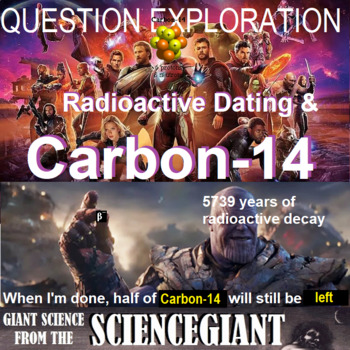Question Exploration: What is Radioactive Dating? (carbon-14 dating)
- Word Document File
Also included in
- Teachers use the Strategic Instruction Model (SIM) Concept Enhancement Routines to transform abstract main ideas and key topics into a concrete representation that helps students think about and talk about the key topic and essential related information. SIM is about promoting effective teaching andPrice $10.85Original Price $15.50Save $4.65
Description
What is radioactive dating? (such as carbon-14 dating). This Question Exploration help Ss explain half-life decay. Radioactive nuclei decay in different amounts of time based on their half-lives. Radioactive decay is the process by which a nucleus becomes stable.
Question Exploration Routine is an instructional methods that teachers can use to help a diverse student population understand a body of content information by carefully answering a critical question to arrive at a main idea answer. Students taught using the question exploration routine earned higher total test scores than did students taught using the lecture-discussion method.
Personally, I use the Question Exploration Routine to figure out what I want to say and how I want to say it. It keeps my "Sage on the Stage" time limited to what fits onto 2-3 pages (about 45 minutes of directed class discussion). This product includes the completed question exploration guide, and the student guide blanked except for vocabulary, scaffolding questions, and graphics already filled in.
The resource also includes
- a Do Now task to be used as a warm-up exercise or after-class review.
- three student activities with problems to be used as laboratory exercises or as an after-class assessment review.
This Question Exploration Routines are classroom tested to help students with the following Florida Next Generation Sunshine State Standards in Science. SWBAT
- SC.7.E.6.3 Identify current methods for measuring the age of Earth and its parts, including the law of superposition and radioactive dating
- SC.7.E.6.4 Explain and give examples of how physical evidence supports scientific theories that Earth has evolved over geologic time due to natural processes.SC.912.P.8.3 Explore the scientific theory of atoms (also known as atomic theory) by describing changes in the atomic model over time and why those changes were necessitated by experimental evidence.
- SC.912.P.8.4 Explore the scientific theory of atoms (also known as atomic theory) by describing the structure of atoms in terms of protons, neutrons and electrons, and differentiate among these particles in terms of their mass, electrical charges and locations within the atom.
- C.912.P.10.10 Compare the magnitude and range of the four fundamental forces (gravitational, electromagnetic, weak nuclear, strong nuclear).
- SC.912.P.10.11 Explain and compare nuclear reactions (radioactive decay, fission and fusion), the energy changes associated with them and their associated safety issues.
- SC.912.P.10.12 Differentiate between chemical and nuclear reactions.
Related Resource
- Half-Life Labs with M&M's, Licorice, and Plain Paper
- Lab: Graphing the Cost Benefits of Nuclear Radiation Treatment
- M&M Math: Candy Counting and Graphing of Mean, Mode, Median, and Range
#StayGiant and stay up on my new resources and STEM news. Look for the green ★ star near the top of any page within my store and click "FOLLOW". Or follow @TheScienceGiant Twitter. Stand on The Shoulders of Giants, and together we'll see further, inspire students, and enlighten inquisitive minds!






